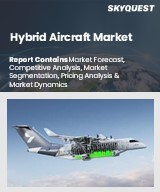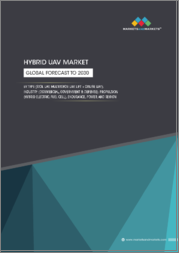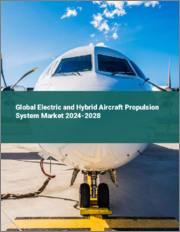
|
시장보고서
상품코드
1838280
하이브리드 항공기 시장 : 시장 규모, 점유율, 성장 분석 - 항공기 유형별, 동력원별, 운용 모드별, 항속 거리별, 양력 기술별, 시스템별, 지역별 산업 예측(2025-2032년)Hybrid Aircraft Market Size, Share, and Growth Analysis, By Aircraft Type, By Power Source, By Mode of Operation, By Range, By Lift Technology, By System, By Region - Industry Forecast 2025-2032 |
||||||
세계의 하이브리드 항공기 시장 규모는 2023년에 21억 달러로 평가되었고, 2024년 24억 7,000만 달러에서 2032년에는 91억 7,000만 달러로 성장할 것으로 예상되며, 예측 기간(2025-2032년) CAGR 17.8%로 성장할 전망입니다.
세계의 하이브리드 항공기 시장은 지속 가능한 항공에 대한 요구와 정부 및 항공 당국이 설정한 탄소 중립 목표에 견인되어 큰 성장을 이루고 있습니다. 차세대 항공기 기술의 발전과 함께 전기 엔진과 기존 엔진을 통합한 하이브리드 추진 시스템 개발에 대한 투자가 증가하고 있습니다. 또한 지역 노선과 단거리 노선에 대한 관심도 높아지고 있으며, 친환경 분야에서 비즈니스 기회가 되고 있습니다. 그러나 높은 연구 개발 비용, 배터리의 낮은 에너지 밀도, 규제상의 장애물과 같은 과제를 해결해야 합니다. 또한 공항의 기존 인프라 제약이 추가 제약입니다. 그럼에도 불구하고 항공기 제조업체와 청정 에너지 기업 간의 새로운 파트너십은 전기화된 도시형 에어모빌리티의 혁신과 함께 이러한 장벽을 극복하는 데 도움이 될 것이며, 하이브리드 항공기 시장을 혁신의 미래를 향해 자리매김하게 됩니다.
목차
서문
- 조사 목적
- 조사 범위
- 정의
조사 방법
- 정보 조달
- 2차 및 1차 데이터의 방법
- 시장 규모 예측
- 시장의 전제조건 및 제한
주요 요약
- 세계 시장 전망
- 공급 및 수요 동향 분석
- 부문별 기회 분석
시장 역학 및 전망
- 시장 개요
- 시장 규모
- 시장 역학
- 성장 촉진요인 및 기회
- 성장 억제요인 및 과제
- Porter's Five Forces 분석
주요 시장 인사이트
- 중요성공요인
- 경쟁도
- 주요 투자 기회
- 시장 생태계
- 시장의 매력 지수(2024년)
- PESTEL 분석
- 거시경제지표
- 밸류체인 분석
- 가격 분석
하이브리드 항공기 시장 규모 : 항공기 유형별 CAGR(2025-2032년)
- 시장 개요
- 지역 수송기
- 비즈니스 제트
- 경량 및 초경량 항공기
- 무인 항공기
- 선진 항공 모빌리티
하이브리드 항공기 시장 규모 : 동력원별 CAGR(2025-2032년)
- 시장 개요
- 연료 하이브리드
- 수소 하이브리드
하이브리드 항공기 시장 규모 : 운용 모드별 CAGR(2025-2032년)
- 시장 개요
- 조종형
- 자율형
하이브리드 항공기 시장 규모 : 항속거리별 CAGR(2025-2032년)
- 시장 개요
- 100km 미만
- 101km-500km
- 501km
하이브리드 항공기 시장 규모 : 양력 기술별 CAGR(2025-2032년)
- 시장 개요
- CTOL
- STOL
- VTOL
하이브리드 항공기 시장 규모 : 시스템별 CAGR(2025-2032년)
- 시장 개요
- 배터리 및 연료전지
- 전기 모터
- 발전기 및 엔진
- 항공구조
- 항공전자기기
- 소프트웨어
- 기타
하이브리드 항공기 시장 규모 : 지역별 CAGR(2025-2032년)
- 북미
- 미국
- 캐나다
- 유럽
- 독일
- 스페인
- 프랑스
- 영국
- 이탈리아
- 기타 유럽
- 아시아태평양
- 중국
- 인도
- 일본
- 한국
- 기타 아시아태평양
- 라틴아메리카
- 브라질
- 기타 라틴아메리카
- 중동 및 아프리카
- GCC 국가
- 남아프리카
- 기타 중동 및 아프리카
경쟁 정보
- 상위 5개사 비교
- 주요 기업의 시장 포지셔닝(2024년)
- 주요 시장 기업이 채용한 전략
- 최근 시장 동향
- 기업의 시장 점유율 분석(2024년)
- 주요 기업의 기업 프로파일
- 기업의 상세
- 제품 포트폴리오 분석
- 기업의 부문별 점유율 분석
- 수익의 전년대비 비교(2022-2024년)
주요 기업 프로파일
- Airbus SE(France)
- RTX Corporation(USA)
- Rolls-Royce plc(UK)
- General Electric(USA)
- Safran SA(France)
- Honeywell International Inc.(USA)
- Embraer SA(Brazil)
- Ampaire Inc.(USA)
- Heart Aerospace AB(Sweden)
- Electra.aero(USA)
- Lilium GmbH(Germany)
- Joby Aviation(USA)
- Beta Technologies(USA)
- magniX(USA)
- Textron Inc.(USA)
- Vertical Aerospace Group Ltd.(UK)
- VoltAero(France)
- AURA AERO(France)
- ZeroAvia(USA)
- Wisk Aero(USA)
결론과 권고
AJYGlobal Hybrid Aircraft Market size was valued at USD 2.1 billion in 2023 and is poised to grow from USD 2.47 billion in 2024 to USD 9.17 billion by 2032, growing at a CAGR of 17.8% during the forecast period (2025-2032).
The global hybrid aircraft market is experiencing significant growth driven by the need for sustainable aviation and carbon-neutral goals set by governments and aviation authorities. Investments are on the rise to develop hybrid propulsion systems that integrate electric and conventional engines, alongside advancements in next-generation aircraft technologies. Interest in regional and short-haul travel is also increasing, presenting opportunities within this eco-friendly sector. However, challenges such as high R&D costs, low battery energy density, and regulatory hurdles must be addressed. Additionally, existing infrastructure limitations at airports pose further constraints. Nevertheless, emerging partnerships between aviation original equipment manufacturers and clean energy firms, along with innovations in electrified urban air mobility, are likely to help overcome these barriers, positioning the hybrid aircraft market for a transformative future.
Top-down and bottom-up approaches were used to estimate and validate the size of the Global Hybrid Aircraft market and to estimate the size of various other dependent submarkets. The research methodology used to estimate the market size includes the following details: The key players in the market were identified through secondary research, and their market shares in the respective regions were determined through primary and secondary research. This entire procedure includes the study of the annual and financial reports of the top market players and extensive interviews for key insights from industry leaders such as CEOs, VPs, directors, and marketing executives. All percentage shares split, and breakdowns were determined using secondary sources and verified through Primary sources. All possible parameters that affect the markets covered in this research study have been accounted for, viewed in extensive detail, verified through primary research, and analyzed to get the final quantitative and qualitative data.
Global Hybrid Aircraft Market Segments Analysis
Global Hybrid Aircraft Market is segmented by Aircraft Type, Power Source, Mode of Operation, Range, Lift Technology, System and region. Based on Aircraft Type, the market is segmented into Regional Transport Aircraft, Business Jets, Light and Ultralight Aircraft, Unmanned Aerial Vehicles and Advanced Air Mobility. Based on Power Source, the market is segmented into Fuel Hybrid and Hydrogen Hybrid. Based on Mode of Operation, the market is segmented into Piloted and Autonomous. Based on Range, the market is segmented into < 100 km, 101 km to 500 km and 501 km. Based on Lift Technology, the market is segmented into CTOL, STOL and VTOL. Based on System, the market is segmented into Batteries & Fuel Cells, Electric Motors, Generators/Engines, Aerostructures, Avionics, Software and Others. Based on region, the market is segmented into North America, Europe, Asia Pacific, Latin America and Middle East & Africa.
Driver of the Global Hybrid Aircraft Market
The Global Hybrid Aircraft market is experiencing significant growth due to the rising demand for innovative solutions that address carbon emissions in the aviation sector. As airlines and regulatory bodies prioritize environmental sustainability, there is a strong drive towards cleaner operational practices. Hybrid propulsion systems present an attractive solution by significantly decreasing fuel consumption and aiding in adherence to evolving sustainability commitments. This shift not only supports the industry's environmental objectives but also demonstrates a proactive approach to meeting the increasing expectations of eco-conscious consumers and stakeholders within the aviation ecosystem.
Restraints in the Global Hybrid Aircraft Market
The Global Hybrid Aircraft market faces significant constraints primarily due to the high financial burden associated with the design, development, and certification processes of these innovative vehicles. The necessity for specialized materials, cutting-edge propulsion technologies, and rigorous safety evaluations contributes to the overall expenses, making it challenging for smaller manufacturers to enter the market. This financial barrier may deter potential investments in hybrid aircraft, limiting their widespread adoption, especially in markets that are particularly sensitive to cost implications. Consequently, the intricate balance between advanced technology and economic viability remains a critical challenge for the growth of this sector.
Market Trends of the Global Hybrid Aircraft Market
The Global Hybrid Aircraft market is witnessing a notable trend towards increased interest in regional air transportation, driven by a demand for more environmentally friendly and cost-effective short-haul travel solutions. Innovations in hybrid-electric propulsion technologies are reshaping the aviation landscape, encouraging manufacturers to design aircraft specifically tailored for commuter and intercity travel. Coupled with government initiatives aimed at promoting low-emission transportation, this shift not only enhances operational efficiency but also aligns with broader sustainability goals. As stakeholders prioritize reduced environmental impact and operational costs, the market for hybrid aircraft is expected to expand, reflecting a significant evolution in regional aviation dynamics.
Table of Contents
Introduction
- Objectives of the Study
- Scope of the Report
- Definitions
Research Methodology
- Information Procurement
- Secondary & Primary Data Methods
- Market Size Estimation
- Market Assumptions & Limitations
Executive Summary
- Global Market Outlook
- Supply & Demand Trend Analysis
- Segmental Opportunity Analysis
Market Dynamics & Outlook
- Market Overview
- Market Size
- Market Dynamics
- Drivers & Opportunities
- Restraints & Challenges
- Porters Analysis
- Competitive rivalry
- Threat of substitute
- Bargaining power of buyers
- Threat of new entrants
- Bargaining power of suppliers
Key Market Insights
- Key Success Factors
- Degree of Competition
- Top Investment Pockets
- Market Ecosystem
- Market Attractiveness Index, 2024
- PESTEL Analysis
- Macro-Economic Indicators
- Value Chain Analysis
- Pricing Analysis
Global Hybrid Aircraft Market Size by Aircraft Type & CAGR (2025-2032)
- Market Overview
- Regional Transport Aircraft
- Business Jets
- Light and Ultralight Aircraft
- Unmanned Aerial Vehicles
- Advanced Air Mobility
Global Hybrid Aircraft Market Size by Power Source & CAGR (2025-2032)
- Market Overview
- Fuel Hybrid
- Hydrogen Hybrid
Global Hybrid Aircraft Market Size by Mode of Operation & CAGR (2025-2032)
- Market Overview
- Piloted
- Autonomous
Global Hybrid Aircraft Market Size by Range & CAGR (2025-2032)
- Market Overview
- < 100 km
- 101 km to 500 km
- 501 km
Global Hybrid Aircraft Market Size by Lift Technology & CAGR (2025-2032)
- Market Overview
- CTOL
- STOL
- VTOL
Global Hybrid Aircraft Market Size by System & CAGR (2025-2032)
- Market Overview
- Batteries & Fuel Cells
- Electric Motors
- Generators/Engines
- Aerostructures
- Avionics
- Software
- Others
Global Hybrid Aircraft Market Size & CAGR (2025-2032)
- North America (Aircraft Type, Power Source, Mode of Operation, Range, Lift Technology, System)
- US
- Canada
- Europe (Aircraft Type, Power Source, Mode of Operation, Range, Lift Technology, System)
- Germany
- Spain
- France
- UK
- Italy
- Rest of Europe
- Asia Pacific (Aircraft Type, Power Source, Mode of Operation, Range, Lift Technology, System)
- China
- India
- Japan
- South Korea
- Rest of Asia-Pacific
- Latin America (Aircraft Type, Power Source, Mode of Operation, Range, Lift Technology, System)
- Brazil
- Rest of Latin America
- Middle East & Africa (Aircraft Type, Power Source, Mode of Operation, Range, Lift Technology, System)
- GCC Countries
- South Africa
- Rest of Middle East & Africa
Competitive Intelligence
- Top 5 Player Comparison
- Market Positioning of Key Players, 2024
- Strategies Adopted by Key Market Players
- Recent Developments in the Market
- Company Market Share Analysis, 2024
- Company Profiles of All Key Players
- Company Details
- Product Portfolio Analysis
- Company's Segmental Share Analysis
- Revenue Y-O-Y Comparison (2022-2024)
Key Company Profiles
- Airbus SE (France)
- Company Overview
- Business Segment Overview
- Financial Updates
- Key Developments
- RTX Corporation (USA)
- Company Overview
- Business Segment Overview
- Financial Updates
- Key Developments
- Rolls-Royce plc (UK)
- Company Overview
- Business Segment Overview
- Financial Updates
- Key Developments
- General Electric (USA)
- Company Overview
- Business Segment Overview
- Financial Updates
- Key Developments
- Safran S.A. (France)
- Company Overview
- Business Segment Overview
- Financial Updates
- Key Developments
- Honeywell International Inc. (USA)
- Company Overview
- Business Segment Overview
- Financial Updates
- Key Developments
- Embraer S.A. (Brazil)
- Company Overview
- Business Segment Overview
- Financial Updates
- Key Developments
- Ampaire Inc. (USA)
- Company Overview
- Business Segment Overview
- Financial Updates
- Key Developments
- Heart Aerospace AB (Sweden)
- Company Overview
- Business Segment Overview
- Financial Updates
- Key Developments
- Electra.aero (USA)
- Company Overview
- Business Segment Overview
- Financial Updates
- Key Developments
- Lilium GmbH (Germany)
- Company Overview
- Business Segment Overview
- Financial Updates
- Key Developments
- Joby Aviation (USA)
- Company Overview
- Business Segment Overview
- Financial Updates
- Key Developments
- Beta Technologies (USA)
- Company Overview
- Business Segment Overview
- Financial Updates
- Key Developments
- magniX (USA)
- Company Overview
- Business Segment Overview
- Financial Updates
- Key Developments
- Textron Inc. (USA)
- Company Overview
- Business Segment Overview
- Financial Updates
- Key Developments
- Vertical Aerospace Group Ltd. (UK)
- Company Overview
- Business Segment Overview
- Financial Updates
- Key Developments
- VoltAero (France)
- Company Overview
- Business Segment Overview
- Financial Updates
- Key Developments
- AURA AERO (France)
- Company Overview
- Business Segment Overview
- Financial Updates
- Key Developments
- ZeroAvia (USA)
- Company Overview
- Business Segment Overview
- Financial Updates
- Key Developments
- Wisk Aero (USA)
- Company Overview
- Business Segment Overview
- Financial Updates
- Key Developments
















